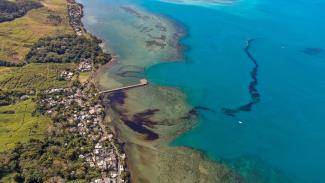Biodiversity
International community misses maritime protection target
 picture-alliance/abaca
In August 2020, an oil-spill had severe impacts on the coast of Mauritius as well as the Blue Bay Marine Park.
picture-alliance/abaca
In August 2020, an oil-spill had severe impacts on the coast of Mauritius as well as the Blue Bay Marine Park.
Protection of the great variety of maritime species is enshrined in the UN Convention on Biological Diversity (CBD) moreover (see Sundus Saleemi in Focus sectin of D+C/E+Z e-Paper 2021/11). In 2010, the CBD’s conference of parties adopted 20 targets in Aichi, Japan. To conserve “at least 17 % of terrestrial and inland water areas and 10 % of coastal and marine areas, especially areas of particular importance for biodiversity and ecosystem services” by 2020 was the 11th Aichi Biodiversity Target. It has not been met.
Currently, only 7.7 % of Earth’s maritime area is protected according to the UN World Database of Protected Areas. This unsatisfying trend is also confirmed by the Global Biodiversity Outlook 5, a report that was prepared on behalf of the CBD Secretariat.
Conservation International, a Washington-based not-for-profit organisation, has identified five key pointers to a successful marine protected area:
- fishing must be completely banned so spawning is not restricted in any way,
- enforcement patrols must take place effectively,
- a large size of about 100 square kilometers is needed,
- proximity to other protected areas is helpful because it allows exchange, and
- long-term protection is important, as biodiversity increases over time.
Research shows, moreover, that marine protected areas serve the health of coral reefs. They also help to manage and replenish fisheries’ stocks outside the protected areas.
The Blue Nature Alliance is an umbrella organisation of non-governmental and multilateral agencies. It wants more ocean space to be protected fast. Its target is to establish an additional 18 million square kilometers of conservation areas by 2025. Relevant regions include Antarctica’s Southern Ocean, Fiji’s Lau Seascape as well as the Seychelles and the wider western Indian Ocean.
Wanjohi Kabukuru is a Kenyan journalist and specialises in environmental affairs.
wkabukuru@gmail.com
@WanjohiK


